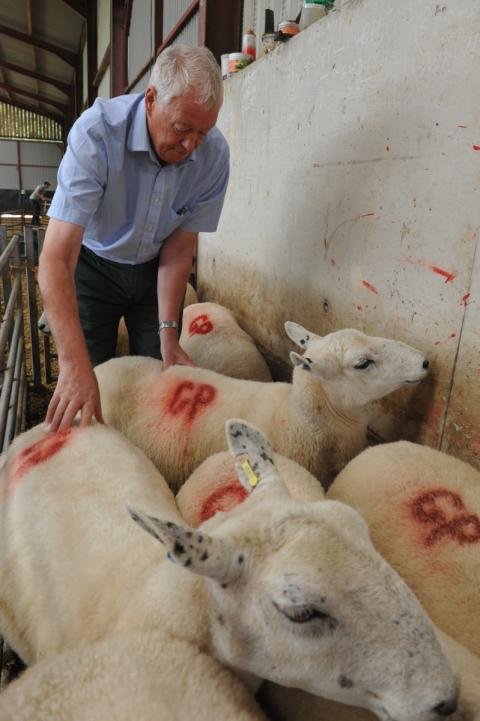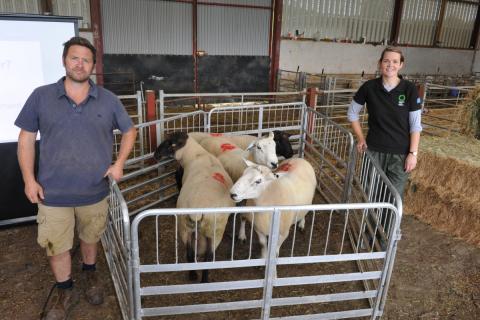31 August 2018
Commercial sheep farmers are being advised to incorporate performance figures into their sire selection this autumn.
Estimated breeding values (EBVs) are a good way of evaluating top genetics but many farmers buy rams on physical appearance only, suggests Dr John Vipond, a senior sheep consultant Scotland’s Rural College (SRUC).
This can be a costly mistake, he says. “When you are buying a ram it must have the figures,’’ he told farmers attending a Farming Connect knowledge transfer event at Dol Y Garn, a sheep farm near Llandrindod Wells.
“Some of the rams being sold for the highest prices are those with the poorest figures. It is time to get some reality back into the situation.’’
EBVs offer many advantages such as improving the weights of finished lambs, carcase confirmation and scanning percentage.
Dr Eleri Price, Supply Chain Development Executive at Hybu Cig Cymru (HCC), says they are an additional tool that ram purchasers should use when selecting sires.
“Maternal and meat yield and meat quality traits can’t be determined from a visual assessment and there are good economic reasons for using EBVs,’’ says Dr Price.
Every farm has different challenges therefore EBVs allow farmers to choose animals that suit their specific situation.
“The first question when buying a ram should be – do you record and, if so, what are your values?’’
Dr Price advises farmers to learn to interpret EBVs. “Use them as a tool and re-evaluate what you need for your business.’’
Figures are important but so too is checking the physical wellbeing of rams before the breeding period.
All rams should undergo an MOT, checking their teeth, testicles and feet, says Dr Vipond.
“Sperm takes eight weeks to mature so if a ram has a really bad abscess or is lame it will affect its sperm production so it is important to check the physical wellbeing of rams before mating and, before making decisions on purchasing, checking their teeth, feet and testicles,’’ he says.
Teeth - shearling rams should have two broad incisors that meet the hard pad at right angles not sloping forward, says Dr Vipond. Cheek teeth can be felt from outside the jaw and should be regular.
Feet - feet should be sound with no inter-digital growths.
Testicles - check there are two testicles that move freely in the scrotum and feel firm but not solid, are free from any hard lumps and have an epididymis the size of a table tennis ball at the base.
A good indicator of a ram’s libido is the skin colour seen on bare areas on the inside of its legs – it will become red in the run up to the breeding season, says Mr Vipond.
“With ewes that are ready for mating, a ram with good libido should mate two ewes straight away,’’ he says.
Elan Davies, Farming Connect Red Meat Technical Officer for south east Wales, says lamb production
relies on rams being fit to work therefore an MOT is vital.
“It is vitally important to take account of the rams performance figures and handle the ram before purchasing it, rather than just relying on visual appearance alone which can be very misleading.’’
“In making any breeding decisions, the more information you gain the better knowledge of the rams you have, his legacy may be with you for years,’’ she says.
Funding for the project has been provided by the Welsh Government’s Rural Communities Rural Development Programme 2014-2020.
Host farmer James Powell says ram selection is one of the most important decisions he makes annually because it underpins flock productivity for the entire year.
He runs a flock of 1000 Aberfield and Aberfield x Perendale ewes, sourcing rams from Innovis or breeding his own tups with maternal attributes.
“Teeth, feet and testicles have to be correct,’’ he insists.
Mr Powell uses rams reared on forages and mates ewes in large mobs – because of this he is confident to allocate 80-100 ewes per ram. The first of these lambs from April 10th.
He uses EBVs to make his ram choices. ““It is 50-50 between aesthetics and figures,’’ he says.
“I am looking for growth and lambing ease on terminals because I am trying to breed a small ewe so I want growth out of the lamb. In my maternal replacements I look for a narrow head and lambing ease.’’
But length is the most important factor. “Everything has got to have length,’’ says Mr Powell.


